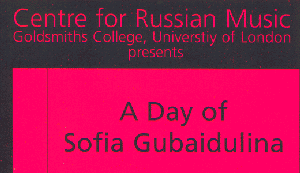
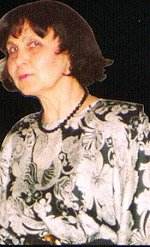
One has to hand it to the Goldsmiths College Centre for Russian Music.
After a seminar day as part of the BBC's Schnittke Weekend in January, it
organised a three-concert celebration of the music of Sofia Gubaidulina,
marking her 70th birthday. Although she has written numerous symphonic works,
the essence of Gubaidulina's music most likely resides in her chamber and
instrumental pieces, making the range on offer here not at all exclusive
or inappropriate.
The opening concert was devoted to the music for string quartet. Written
back in 1971, the First Quartet is temporally and, to a degree, aesthetically
isolated from its successors. The process of fragmentation which the piece
charts is given a graphic dimension by the players' gradual moving to the
edge of the platform; executed a little too self-consciously by the Moscow
Quartet, though the trestle-like platform of the Purcell Room hardly encourages
decisive movement. The music itself is pungent rather than gripping, distinctive
rather than memorable; Galina Ustvolskaya would tackle not dissimilar procedures
more unequivocally in her work of the mid-1970s.
Quartets Two and Three both date from 1987, at a time when Gubaidulina was
fast becoming a major figure in the West. Both works juxtapose contrasting
types of material: single notes and chords in the former, pizzicato and arco
writing in the latter, whose spontaneous interplay and convincing resolution
of separate components makes it the most satisfying of the cycle. Quartet
No. 4 (1993) blends both tape and light media into the musical substance,
though the latter was not realisable on this occasion, and the taped quartet
sounds hardly widened the scope of a piece in which the contrast between
'light and shadow' is passingly but not intensively conveyed.
The String Trio (1988), however, impressed with its formal dialectic untypical
of this composer. The contrast between the real and the transcendent is played
out with an immediacy recalling Schnittke's work from the period, and the
whole work is a valuable contribution to a compositionally 'difficult' medium.
As elsewhere, the Moscow Quartet make up for occasional fallibilities in
ensemble with a conviction that projected the music unsparingly to the audience,
who were clearly buckling under the strain of near-on 90 minutes of absorbing
but concentrated listening.
The 7.30 concert bid us enter 'The Magic World of Sofia Gubaidulina'
- in which the bayan (a button concert accordion popular in Russia
and the Baltic countries and increasingly spreading to the West) featured
prominently, as it does in the composer's output. In the hands of Elsbeth
Moser, the solo De Profundis (1978) effortlessly combined the
provocation of a new sound resource with the timelessness of a traditional
instrument. Dancer on a Tightrope (1993) had a more pronounced theatrical
dimension; ably carried out by violinist Daniel Hope and pianist
Jean-Pierre Armengaud, it rather overshadowed the intrinsic musical
aspect, notably the "flight into another existence" that the composer has
spoken of in connection with the piece.
This last concert was dominated by two substantial five-piece cycles.
Silenzio (1991) brought Moser, Hope and cellist Alexander Ivashkin
together in a series of intense and often animated pieces that interestingly,
but not altogether successfully, throw new light on the possibilities of
ensemble playing. In particular, the ample resonance and sustaining harmonies
of the bayan often seemed to clog rather than enhance the cross-play of violin
and cello. The latter were heard to better advantage in Rejoice! (1988),
an instrumental Mass whose biblical movement-titles underline the music's
passionate inwardness; in its cumulative sense of ecstatic transfiguration,
unerringly conveyed by Hope and Ivashkin, the undoubted highlight of the
series.
While Gubaidulina's often stark musical vision may not be as accessible to
audiences as that of Schnittke, it remains a compulsive and often persuasive
testament to artistic individuality, and may even transcend its period more
completely over time. The Centre for Russian Music is to be commended for
putting on this welcome and sympathetic overview.
Richard Whitehouse
One of the Sunday afternoon concerts at the Purcell Room was devoted to Gubaidulina and the cello, featuring Alexander Ivashkin, internationally renowned cellist and Director of the Centre for Russian Music at Goldsmiths. Gubaidulina's Ten Preludes for solo cello (1974) - originally entitled 'Ten Studies' - tackle traditional techniques but in unusual ways. Intended as pedagogical exercises, they became far more, and are really studies in expression with coloursitic timbres and powerful emotional content. The original title should have been retained, linking them with the line of piano Études by Chopin, Debussy & Ligeti, and they might thereby have become better established in the repertoire. Despatched by Ivashkin with aplomb, they are effective, easy to appreciate and enjoy, and would make for a welcome solo interlude in any cello recital. With Elsbeth Moser, on bayan instead of the original organ, Ivashkin played the moving In Croce with a reversal of roles and registers as the piece proceeds. This absorbing hour ended with Quaternion (1996) for cello quartet, with two of the cellos tuned a quarter-tone flat, an example of this composer's continual sonic searching.
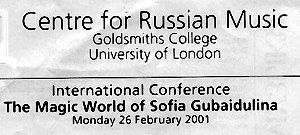
The following afternoon, I was able to attend part (only) of a conference at Goldsmiths College devoted to Sofia Gubaidulina, but this was revelatory.
Michael Kurtz sketched in her Biography, after which Dr Razia Sultanova described researches about the composer's early family life. From Sofia's sister Dr Sultanova learned that the future composer used to experience the sound of the daily prayers of her grandmother, who was a religious 'clerk' in the chief Muslim centre of Kazan. In the 1930s Islam was criminalised in the war against religion, the Mullahs and their pupils were persecuted and, Gubadulina's grandmother included, exiled. She would have absorbed the sounds of Muslim incantation unconsciously in early childhood and, although not a religious believer herself, came back to this rich sound source with its range of tones from quiet to shrill and soft to hard, all chanted, in contrast with Christian worship. She was struck by the beauty of the three Muslim prayer forms, with short melodious musical incantations with 3 or 4 note descending figures, and her music has often been described as 'like a prayer', e.g. the ostinato in the fourth quartet.
After the lecture I verified a link I had suspected between Sofia Gubaidulina & Giacinto Scelsi, whom I had visited at his home overlooking the Forum at Rome, 'at the border between East and West', himself greatly influenced by thought and music of the Orient - it was confirmed in discussion that Gubaidulina had got to know Scelsi's music in the 1980s and that it had indeed influenced her own composing.
Dr Valeria Tsenova from Moscow tackled Number mysteries in the music of Sofia Gubadulina and from her study of archive material in Basle has found that numerology is all important in this composer's planning. The music is quantified from beginning to end of a whole work. None of her works is without numerical structures, with the Fibonacci series prominent since the 1980s and Lucan sequences also since 1993, with her Shortly before waking for koto combining both series. Dr Tsenova discussed Gubadulina's Meditation on Bach's chorale Vor deinem Thron and assured us that numerical relations were not accidental for J S Bach; Gubadulina's is the most diverse treatment of them of all composers. None of this is perceptible by the ordinary listener, but gives an underlying strength to the substance of her compositions.
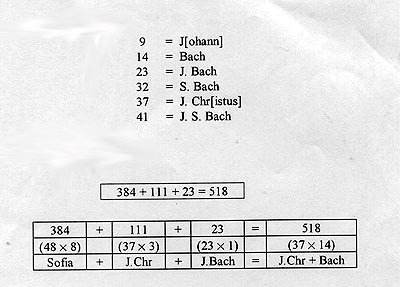
Peter Grahame Woolf
Recordings
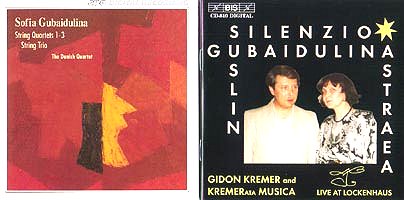
Sofia Gubaidulina is well represented in the BIS catalogue. The documentation in the BIS releases is notably thorough and interesting to read.
Gubaidulina's Meditation on Bach's chorale Vor deinem Thron, Silenzio & Dancer on a Tightrope are all on BIS CD 810 and this varied programme is an ideal adjunct to the Purcell Room concerts and a good first choice as an introduction for collectors new to this composer.
Both these CDs are well played & recorded and thoroughly recommendable. They are distributed by Select
GUBAIDULINA String Quartets 1 - 3; String
Trio The Danish Quartet
CPO 999 064-2 [70 mins] (PGW)
AmazonUK
This CD was received for review in connection with the above report on Sofia Gubaidulina at South Bank and Goldsmith's College. Gubaidulina's four string quartets constitute an important line in her oeuvre, and it is good to have the first three gathered together with the trio which she wrote soon after quartet no 3. I doubt whether she would favour listening to them straight through, as happened in the Purcell Room, for there is a degree of repetition of self-referential gestures, of which she is no doubt well aware.
The first quartet (1971) hints at personal conflict, with abstract preoccupations with form and (numerical) balances subverted by a musico-theatrical presentation, the players gradually edging backwards from the centre of the platform, increasingly farther from each other. Nothing is quite what it seems, and a final cello litany brings desolation instead of any comfort. The concise No 2 (1987) is replete with rubato, espressivo & vibrato indications with many flageolets & glissandi, 'intensity through approximation to the ineffable' (Vera Lumpe). The third features many pizzicato colourations and fluctuations of movement in quintuplets, sextuplets and septuplets, with bowed tones a late, special event. The string trio explores modes of communication between the participants, recalling that of the first quartet, first all three interacting, next violin and cello against viola, and finally each instrument individually.
The performances and recording sound exemplary, a fine pendant to treasure after the memorable live experience.
Peter Grahame Woolf
 Return to:
Return to: